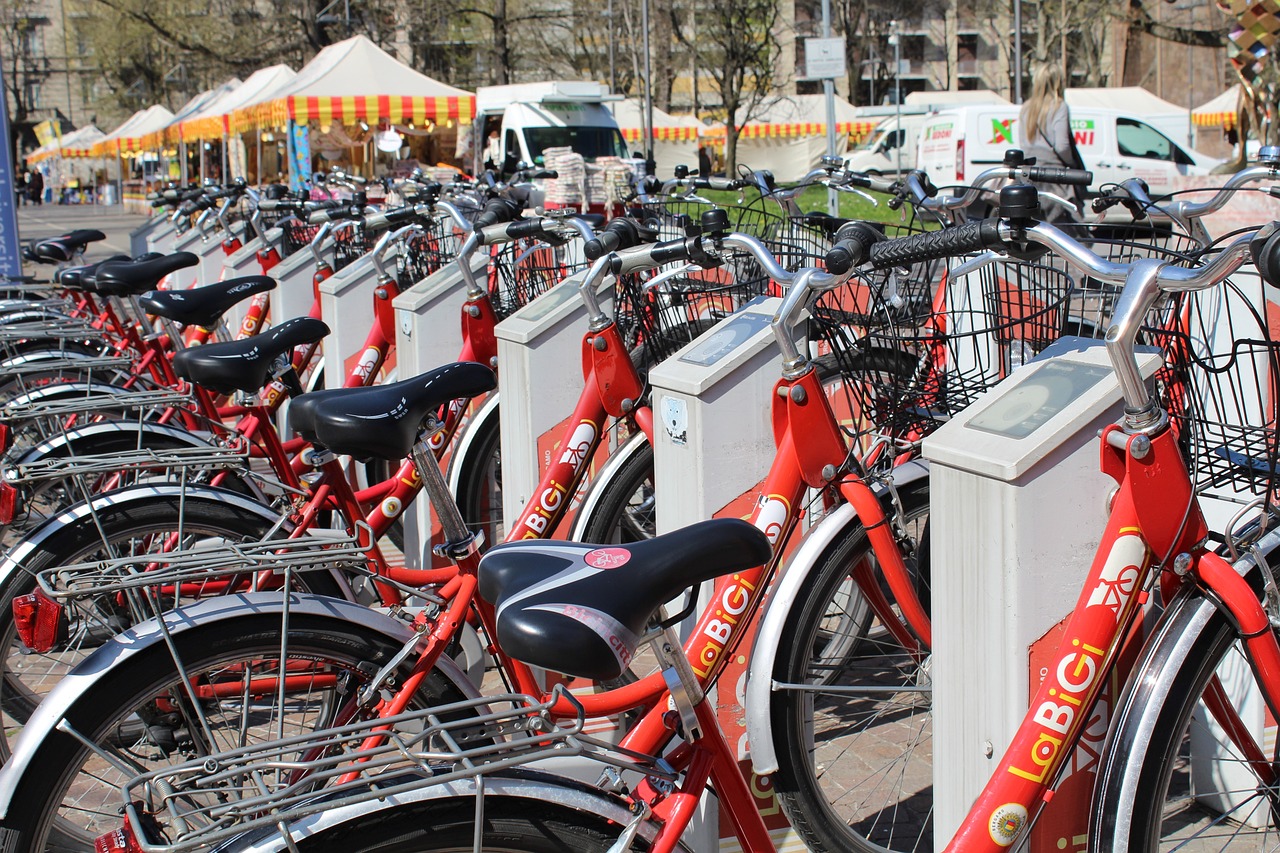How to Promote Sustainability in Your Neighborhood?
In today’s world, the concept of sustainability is not just a buzzword; it’s a necessity. As we face increasing environmental challenges, the question arises: how can we make a difference right from our own backyards? Promoting sustainability in your neighborhood can be both an exciting and fulfilling journey. It’s about creating a thriving community that values the environment, encourages eco-friendly practices, and fosters a healthier lifestyle for everyone involved. Imagine transforming your local area into a green haven where residents take pride in their surroundings and work together towards a common goal. Sounds appealing, right? Let’s dive into some effective strategies and initiatives that can help you and your neighbors embrace sustainability and make a lasting impact.
Sustainability encompasses practices that meet current needs without compromising future generations. It's like planting a tree today that will provide shade and fruit for years to come. Understanding this concept is crucial for fostering a community that prioritizes eco-friendly living. When local communities embrace sustainable practices, they not only enhance the environment but also improve the quality of life for residents. Think about it: cleaner air, healthier ecosystems, and a stronger sense of community. By making small changes collectively, we can create a ripple effect that leads to significant improvements in our neighborhoods.
Engaging community members is crucial for promoting sustainability. After all, change starts with people! One effective way to involve residents in sustainability initiatives is through community meetings or workshops. These gatherings can serve as platforms for sharing ideas, brainstorming solutions, and discussing the importance of sustainable practices. Additionally, consider forming local sustainability committees or groups that can spearhead projects and keep the momentum going. When people feel a sense of ownership and responsibility towards their environment, they are more likely to take action. It’s about building a community spirit that thrives on collaboration and mutual support.
Reducing waste is a key component of sustainability. Have you ever thought about how much waste your neighborhood generates? It’s staggering! By implementing effective waste reduction strategies, we can significantly decrease our environmental footprint. For instance, launching a recycling program can encourage residents to separate their waste, while composting initiatives can turn organic materials into nutrient-rich soil. Organizing community clean-up events is another fantastic way to get everyone involved—imagine the satisfaction of seeing your neighborhood sparkle after a collective effort! It’s not just about reducing waste; it’s about creating a culture of sustainability.
Improving energy efficiency can significantly reduce a neighborhood's carbon footprint. Simple steps like conducting energy audits can help residents identify areas where they can save energy. Have you considered installing solar panels? They’re a fantastic investment that not only reduces electricity bills but also promotes renewable energy. Additionally, community workshops on energy-saving practices can empower residents to make informed choices. Every little bit counts, and when everyone pitches in, the impact can be monumental!
Encouraging alternative transportation methods helps reduce emissions. Think about the last time you walked or biked instead of driving. It felt good, didn’t it? Promoting walking, biking, carpooling, and using public transit can transform the way we navigate our neighborhoods. Consider organizing bike rides or walking groups to foster a sense of community while reducing reliance on cars. Not only does this benefit the environment, but it also promotes healthier lifestyles. Let’s make our streets more pedestrian-friendly and create a culture that values sustainable transportation!
Creating green spaces and urban gardens enhances biodiversity and community well-being. Imagine a vibrant community garden where neighbors come together to grow fresh produce, share gardening tips, and enjoy the beauty of nature. Urban gardening initiatives can significantly contribute to sustainability by promoting local food production and reducing food miles. Additionally, green spaces provide habitats for wildlife and improve air quality. It’s a win-win situation! By investing in our local environment, we’re investing in our health and happiness.
Water conservation is essential for sustainability. With increasing water scarcity, it’s vital to adopt practices that reduce water usage in homes and gardens. Simple measures like fixing leaks, using water-efficient appliances, and implementing drought-resistant landscaping can make a big difference. Have you ever thought about rainwater harvesting? It’s a fantastic way to collect and use rainwater for irrigation, reducing the strain on our water supply. By being mindful of our water consumption, we can ensure that future generations have access to this precious resource.
Raising awareness about sustainability is vital for community action. Educational programs and campaigns can inform residents about sustainable practices and their benefits. Consider hosting workshops, creating informational flyers, or utilizing social media to spread the word. The more people know, the more likely they are to get involved! When residents understand the impact of their actions, they are more likely to adopt eco-friendly habits. Let’s empower our communities with knowledge and inspire them to take action!
Collaboration among residents can amplify sustainability efforts. By working together, communities can achieve common goals that might be challenging for individuals to tackle alone. Successful community projects, such as tree planting days or neighborhood clean-up drives, demonstrate the power of collective action. When everyone pitches in, not only do we achieve more, but we also strengthen our community bonds. It’s about creating a supportive environment where everyone feels valued and motivated to contribute.
Q: How can I get my neighbors involved in sustainability initiatives?
A: Start by hosting a community meeting to discuss ideas and gather input. You can also create a social media group to share information and plan events.
Q: What are some simple changes I can make at home to be more sustainable?
A: Consider reducing plastic use, conserving water, and using energy-efficient appliances. Small changes can lead to significant impacts over time!
Q: How can I support local sustainability projects?
A: Volunteer your time, donate resources, or simply spread the word about these initiatives. Every bit of support helps!

Understanding Sustainability
Sustainability is more than just a buzzword; it's a way of life that strives to balance our needs with the health of our planet. Imagine a world where we can meet our current needs without jeopardizing the ability of future generations to meet theirs. This concept is rooted in the idea that every action we take today has a ripple effect on tomorrow’s environment, economy, and society. By embracing sustainable practices, we can create a better world not only for ourselves but also for those who will come after us.
At its core, sustainability is about interconnectedness. It emphasizes the importance of understanding how our actions impact the environment and the community around us. For instance, when we choose to recycle rather than throw away our waste, we’re not just cleaning up our neighborhoods; we’re also conserving natural resources and reducing pollution. This simple act can lead to a healthier ecosystem, which in turn supports our well-being. It’s like planting a seed today that will grow into a tree providing shade and fruit for generations.
Communities play a pivotal role in fostering sustainability. By coming together and adopting eco-friendly practices, neighborhoods can significantly reduce their carbon footprints. This collective effort can manifest in various ways, such as:
- Organizing community clean-up days to remove litter and promote pride in local spaces.
- Implementing recycling programs that make it easy for residents to participate.
- Encouraging local businesses to adopt sustainable practices, creating a ripple effect throughout the community.
Moreover, sustainability is not just about environmental benefits; it also brings social and economic advantages. For example, when communities invest in green spaces, they enhance the quality of life for residents, fostering a sense of belonging and community pride. Economically, sustainable practices can lead to cost savings, such as reduced energy bills from energy-efficient homes or lower food costs from community gardens.
In summary, understanding sustainability is about recognizing our responsibility to the planet and each other. It’s about making informed choices that contribute to a healthier, more equitable world. As we delve deeper into the various strategies and initiatives that can be implemented at the community level, remember that every small step counts. Together, we can cultivate a sustainable future that benefits everyone.

Community Engagement
When it comes to promoting sustainability, is absolutely essential. Imagine a neighborhood where everyone is actively involved in making eco-friendly choices; it’s like a well-oiled machine that runs smoothly, benefiting both the environment and the residents. But how do we get there? The key lies in fostering a sense of ownership and responsibility among residents. By involving them in sustainability initiatives, we can create a vibrant community that cares for its surroundings.
One effective way to engage residents is through community workshops. These workshops can cover various topics such as composting, energy efficiency, and sustainable gardening. Not only do they provide valuable information, but they also create a platform for residents to share their ideas and experiences. It’s like planting seeds of knowledge that can grow into a lush garden of sustainable practices.
Another dynamic approach is to establish neighborhood committees focused on sustainability. These committees can serve as a hub for organizing events like clean-up drives, tree-planting days, or even community potlucks that celebrate local produce. By working together, residents can foster a sense of camaraderie and shared purpose. It’s amazing how a simple gathering can transform into a powerful movement for change!
Social media also plays a crucial role in engaging the community. Platforms like Facebook, Instagram, and Twitter can be utilized to spread the word about sustainability initiatives, share success stories, and encourage participation in upcoming events. Imagine a neighborhood group where residents post pictures of their compost bins or share tips on reducing plastic use. This digital camaraderie can inspire others to join the cause.
Moreover, local businesses can become allies in promoting sustainability. By partnering with shops and restaurants, communities can create incentives for eco-friendly practices. For instance, offering discounts to customers who bring reusable bags or containers can encourage more sustainable shopping habits. It’s a win-win situation; businesses get more customers, and residents adopt greener practices.
Lastly, it’s vital to celebrate achievements, no matter how small. Recognizing individuals or groups who make significant contributions to sustainability can motivate others to follow suit. Whether it’s through awards, shout-outs on social media, or community newsletters, acknowledging these efforts can create a ripple effect, inspiring even more residents to engage in sustainable practices.
In summary, community engagement is the heartbeat of any successful sustainability initiative. By bringing people together, providing them with the tools and knowledge they need, and celebrating their efforts, we can cultivate a community that not only cares for its environment but thrives because of it. So, let’s roll up our sleeves and get involved—after all, a sustainable future begins right in our own neighborhoods!

Waste Reduction Strategies
Reducing waste is not just a trend; it’s a necessity for a sustainable future. Imagine living in a neighborhood where trash is minimized, recycling is maximized, and every resident plays a part in protecting the environment. Sounds appealing, right? To make this vision a reality, we need to adopt effective waste reduction strategies that can significantly lessen our environmental footprint. By implementing these strategies, we can create a cleaner, healthier community that benefits everyone.
One of the most impactful ways to reduce waste is through comprehensive recycling programs. These programs not only encourage residents to recycle but also make it easy for them to do so. For instance, providing clearly labeled bins for different materials—like plastics, paper, and metals—can help streamline the recycling process. Additionally, organizing community workshops to educate residents about what can and cannot be recycled is crucial. Did you know that many people are unaware that certain items, like pizza boxes or plastic bags, often cannot be recycled? By spreading awareness, we can improve recycling rates and reduce contamination in the recycling stream.
Another effective strategy is composting. Composting not only reduces the amount of organic waste that ends up in landfills but also creates nutrient-rich soil that can be used in gardens and landscaping. Community composting programs can be established, where residents can drop off their compostable materials. This initiative not only helps the environment but also fosters a sense of community as neighbors come together to support a common goal. Imagine the joy of turning kitchen scraps into rich compost that nourishes local gardens!
Moreover, organizing community clean-up events can have a profound impact on waste reduction. These events not only help to beautify the neighborhood but also raise awareness about litter and its effects on the environment. When residents come together to pick up trash, they develop a sense of ownership and pride in their community. It’s a great way to connect with neighbors while making a tangible difference. Plus, these events can be fun! Think of it as a community party with a purpose.
To further enhance waste reduction efforts, it’s essential to promote a culture of mindful consumption. This means encouraging residents to think critically about their purchasing habits. Are they buying items with excessive packaging? Are they choosing single-use products over reusable ones? By fostering discussions around these topics, communities can inspire individuals to make more sustainable choices. Consider hosting workshops that teach residents about minimalism and the benefits of buying second-hand or opting for products with less packaging.
In conclusion, waste reduction strategies are not just about cutting down on trash; they are about creating a sustainable lifestyle that benefits everyone in the community. By implementing recycling programs, promoting composting, organizing clean-up events, and encouraging mindful consumption, neighborhoods can significantly reduce their waste output. The journey to a more sustainable future starts at the local level, and with collective effort, we can pave the way for a cleaner, greener environment.
- What are the benefits of composting? Composting reduces waste sent to landfills, enriches soil, and helps plants grow.
- How can I get involved in local recycling programs? Check with your local government or community center for information on recycling initiatives in your area.
- What items can I compost? Most kitchen scraps, yard waste, and paper products can be composted. However, avoid meat, dairy, and oily foods.
- How often should community clean-up events be held? It varies by community, but quarterly events can keep the neighborhood clean and foster community spirit.

Energy Efficiency Initiatives
In today's world, where energy consumption is skyrocketing, improving energy efficiency has become more crucial than ever. Not only does it help reduce our carbon footprint, but it also leads to significant cost savings for households and businesses alike. Imagine walking into your home and feeling a sense of relief knowing your energy bills are lower, all while contributing to a healthier planet. Sounds appealing, right? Well, implementing energy efficiency initiatives in your neighborhood can make this dream a reality.
One of the first steps towards enhancing energy efficiency is conducting an energy audit. This process involves a thorough examination of your home to identify areas where energy is being wasted. Think of it as a health check-up for your house! During an energy audit, professionals will evaluate insulation, heating and cooling systems, and even lighting. The insights gained can help homeowners make informed decisions about upgrades and improvements. For instance, did you know that simply improving your insulation can lead to a reduction of up to 20% in energy costs? That's a significant saving!
Another effective initiative is the installation of solar panels. By harnessing the power of the sun, residents can significantly reduce their reliance on fossil fuels. Not only does this contribute to a sustainable future, but many local governments also offer incentives and rebates to offset the initial costs of installation. It's like getting paid to go green! Additionally, solar energy can increase property values, making it a win-win situation for homeowners.
Beyond individual actions, promoting community-wide energy-saving practices can create a ripple effect. For example, organizing workshops to educate residents about energy-efficient appliances and smart home technologies can empower them to make better choices. Consider hosting a neighborhood event where participants can share tips on how they’ve reduced their energy consumption. This not only fosters community spirit but also encourages everyone to adopt more sustainable habits.
To illustrate the potential impact of these initiatives, let's take a look at a hypothetical neighborhood before and after implementing energy efficiency measures:
| Measure | Before Implementation | After Implementation |
|---|---|---|
| Average Energy Bill | $200/month | $140/month |
| Carbon Footprint | 5 tons/year | 3 tons/year |
| Households with Solar Panels | 0% | 30% |
As shown in the table above, the transition to energy-efficient practices not only leads to lower energy bills but also contributes to a significant reduction in carbon emissions. This transformation can inspire neighboring communities to follow suit, creating a larger movement towards sustainability.
In conclusion, embracing energy efficiency initiatives is not just about saving money; it’s about creating a sustainable future for ourselves and generations to come. By conducting energy audits, installing solar panels, and fostering community education, we can transform our neighborhoods into models of sustainability. So, are you ready to take the first step towards a greener, more energy-efficient community?
- What is an energy audit? An energy audit is an assessment that identifies how much energy your home uses and suggests ways to improve efficiency.
- How much can I save by switching to solar energy? Savings vary by location and energy use, but many homeowners see reductions of 50% or more in their energy bills.
- Are there incentives for energy efficiency upgrades? Yes, many local and federal programs offer tax credits, rebates, and other incentives for energy-efficient home improvements.

Green Transportation Options
When we think about making our neighborhoods more sustainable, one of the first areas that come to mind is transportation. It’s no secret that traditional vehicles contribute significantly to air pollution and greenhouse gas emissions. So, how can we shift gears towards a greener future? By embracing alternative transportation methods, we can not only reduce our carbon footprint but also foster a sense of community and enhance our overall quality of life.
Imagine this: instead of sitting in traffic, you and your neighbors are biking along a scenic route, enjoying the fresh air and each other’s company. Sounds appealing, right? Biking is one of the most effective ways to promote sustainable transportation. It’s not just good for the environment; it’s also great for your health! Not to mention, it can save you money on gas and parking fees. Communities can encourage biking by creating dedicated bike lanes, providing bike-sharing programs, and organizing group rides. This way, biking becomes not just a mode of transport but a fun community activity.
But biking isn’t the only option on the table. Carpooling is another fantastic way to cut down on emissions. When you share a ride with others, you’re not only reducing the number of cars on the road but also building relationships with your neighbors. Think of it as a mini road trip—complete with good conversation and laughter! Local governments can facilitate carpooling by setting up designated carpool spots and promoting apps that connect drivers with passengers. It’s a win-win situation!
Let’s not forget about public transportation. Investing in efficient and reliable public transit systems can significantly reduce the number of single-occupancy vehicles on the road. Imagine hopping on a bus or train that runs frequently and takes you directly to your destination without the hassle of traffic and parking. Communities can advocate for improved public transit options and even organize community events to raise awareness about the benefits of using public transport.
Walking is perhaps the simplest and most sustainable option of all. It’s free, healthy, and requires no fuel! By creating pedestrian-friendly infrastructure—like sidewalks, crosswalks, and safe street crossings—communities can encourage residents to leave their cars at home. It’s not just about getting from point A to point B; it’s about enjoying the journey and connecting with your surroundings. Imagine strolling down a tree-lined street, greeting neighbors, and soaking in the beauty of your neighborhood.
To sum it all up, embracing green transportation options is essential for fostering a sustainable neighborhood. By promoting biking, carpooling, public transit, and walking, we can create a vibrant community that values both the environment and the well-being of its residents. So, why not take the first step today? Consider how you can incorporate these options into your daily routine and inspire others to do the same. Together, we can drive change—literally!
- What are some benefits of using public transportation? Public transportation reduces traffic congestion, lowers greenhouse gas emissions, and can save money on fuel and parking.
- How can I encourage my neighbors to bike more? Organize community bike rides, create bike lanes, and promote bike-sharing programs to make biking more accessible and enjoyable.
- What should I do if my neighborhood lacks pedestrian infrastructure? Advocate for better sidewalks and crosswalks through community meetings, and collaborate with local officials to prioritize pedestrian safety.

Urban Gardening and Green Spaces
Urban gardening and the creation of green spaces are vital components of fostering a sustainable neighborhood. Imagine stepping outside your door and being greeted not by concrete and asphalt, but by vibrant gardens bursting with life! These green spaces do more than just beautify our surroundings; they play a crucial role in enhancing biodiversity, improving air quality, and even boosting our mental well-being. Think of urban gardens as little oases in the bustling city, where residents can reconnect with nature, grow their own food, and cultivate a sense of community.
One of the most significant benefits of urban gardening is its ability to provide fresh produce right at our doorstep. With a little effort, anyone can transform a small patch of land, a balcony, or even a windowsill into a thriving garden. This not only reduces the carbon footprint associated with transporting food but also encourages healthier eating habits. Imagine the satisfaction of plucking a ripe tomato from your own garden and tossing it into a salad! It’s not just food; it’s a connection to the earth and to each other.
Moreover, green spaces serve as vital habitats for local wildlife. Birds, bees, and butterflies thrive in areas where plants flourish. By creating urban gardens, we can help support these species, which are essential for pollination and maintaining ecological balance. A diverse ecosystem within our neighborhoods leads to healthier environments and contributes to the overall resilience of our communities. Just picture a neighborhood buzzing with life, where children can learn about nature firsthand, and adults can unwind in a serene setting after a long day.
However, establishing urban gardens and green spaces requires collaboration and community involvement. Residents can come together to form gardening clubs, participate in community planting days, or even create neighborhood beautification committees. These initiatives not only foster a sense of ownership but also build relationships among neighbors. When people work side by side, they cultivate not just plants but also friendships and a shared commitment to sustainability.
To further illustrate the impact of urban gardening, let’s look at a few successful examples:
| Community Garden Name | Location | Established | Key Features |
|---|---|---|---|
| Green Thumb Garden | Downtown | 2015 | Herb beds, composting area, community workshops |
| Harvest Haven | East Side | 2018 | Fruit trees, children's play area, rainwater harvesting |
| City Oasis | West End | 2020 | Native plants, butterfly garden, meditation space |
In conclusion, urban gardening and the development of green spaces are not just trendy movements; they are essential strategies for promoting sustainability in our neighborhoods. By embracing these practices, we can create healthier, happier, and more connected communities. So why not take the first step today? Whether it's starting a small herb garden or joining a local gardening group, every little effort counts towards a greener future!
- What is urban gardening? Urban gardening refers to the practice of cultivating, processing, and distributing food in or around urban areas.
- How can I start my own urban garden? Begin by assessing your available space, selecting suitable plants for your environment, and gathering necessary supplies. Local gardening clubs can also provide valuable resources and support.
- What are the benefits of green spaces in urban areas? Green spaces improve air quality, support biodiversity, enhance mental health, and provide recreational opportunities for residents.
- Can urban gardening help with food insecurity? Yes, urban gardening can provide fresh produce to communities that may lack access to healthy food options, thereby addressing food insecurity.

Water Conservation Practices
Water conservation is not just a buzzword; it’s a necessity in today’s world. With the increasing challenges posed by climate change and population growth, every drop counts! By implementing effective water conservation practices in your neighborhood, you can contribute to a more sustainable future. Imagine a world where clean water is available for everyone, and your community is leading the way in making that a reality. So, how can we get started?
One of the most impactful strategies is to promote rainwater harvesting. This technique involves collecting and storing rainwater from rooftops, which can then be used for irrigation, flushing toilets, or even washing cars. Not only does this reduce the demand on municipal water supplies, but it also minimizes stormwater runoff, which can lead to flooding and pollution in local waterways. Consider hosting a workshop to educate residents on how to set up their own rainwater collection systems. It’s easier than it sounds, and the benefits are immense!
Another excellent practice is to encourage drought-resistant landscaping. By choosing native plants that require less water, residents can create beautiful gardens that thrive even in dry conditions. Not only does this save water, but it also supports local wildlife and enhances the overall aesthetics of the neighborhood. You can organize community planting days where residents come together to plant these resilient species, fostering a sense of unity while beautifying the area.
Additionally, it’s essential to promote the use of water-efficient appliances. Many households are still using outdated fixtures that waste significant amounts of water. By replacing old toilets with low-flow models or installing water-saving showerheads, families can reduce their water usage dramatically. To make this transition easier, consider collaborating with local hardware stores to offer discounts on these eco-friendly products. A little incentive can go a long way in encouraging residents to make the switch.
Education plays a crucial role in water conservation. Hosting community seminars or creating informational pamphlets that provide tips on how to reduce water waste can empower residents. For instance, simple actions like turning off the tap while brushing teeth or fixing leaks promptly can lead to substantial savings. You might even consider launching a friendly competition to see which household can reduce their water usage the most over a month. Not only does this raise awareness, but it also makes conservation fun!
To illustrate the impact of these practices, let’s take a look at a hypothetical scenario:
| Practice | Water Saved per Year (in gallons) |
|---|---|
| Rainwater Harvesting | 1,000 |
| Drought-Resistant Landscaping | 500 |
| Water-Efficient Appliances | 2,000 |
| Community Education | 300 |
As you can see, even small changes can lead to significant water savings. By working together, your neighborhood can make a substantial impact on water conservation efforts. Remember, every little bit helps, and when everyone pitches in, the results can be astounding!
Q: How can I start rainwater harvesting in my home?
A: You can start by installing a rain barrel under your downspout. Make sure to use a screen to keep debris out and consider adding a spigot for easy access to the collected water.
Q: What are some drought-resistant plants I can use in my garden?
A: Some popular drought-resistant plants include succulents, lavender, and ornamental grasses. These plants are not only beautiful but also require minimal water.
Q: How much water can I save by switching to low-flow fixtures?
A: Depending on your household size and usage, switching to low-flow fixtures can save a family of four up to 20,000 gallons of water per year!
Q: What are some common water-wasting habits I should avoid?
A: Common habits include leaving the tap running while brushing teeth, taking long showers, and not fixing leaks promptly. Being mindful of these can significantly reduce water waste.

Education and Awareness Campaigns
Education and awareness are the backbone of any successful sustainability initiative. Imagine living in a neighborhood where everyone is on the same page about eco-friendly practices. Sounds great, right? Well, it’s not just a dream; it can be a reality through effective education and awareness campaigns. These campaigns play a crucial role in informing residents about the importance of sustainability and the simple steps they can take to make a difference.
One of the most effective ways to spread awareness is through community workshops and seminars. These gatherings allow residents to engage with experts who can provide valuable insights into sustainable practices. For instance, a local environmentalist might conduct a workshop on composting, demonstrating how to turn kitchen scraps into nutrient-rich soil. This hands-on approach not only educates but also inspires participants to adopt these practices in their own homes.
Moreover, leveraging social media platforms can amplify the reach of sustainability messages. By creating dedicated community pages or groups, residents can share tips, resources, and success stories. Imagine a Facebook group where neighbors post photos of their garden harvests or share their experiences with energy-saving home improvements. This not only builds community spirit but also encourages others to join the movement. It’s like watching a snowball grow as it rolls down a hill—each new participant adds to the momentum.
In addition to workshops and social media, schools can play a pivotal role in promoting sustainability. Integrating environmental education into the school curriculum can instill a sense of responsibility in children from a young age. Schools can organize field trips to local parks or nature reserves, allowing students to connect with the environment firsthand. By fostering this connection, we can cultivate a new generation of environmentally-conscious citizens.
To further enhance these efforts, community newsletters or bulletins can be an effective tool for sharing information. These publications can feature articles on local sustainability initiatives, tips for reducing waste, and profiles of residents who are making a difference. By keeping the community informed, we can create a culture of sustainability that is both engaging and impactful.
Here’s a quick overview of some effective strategies for education and awareness campaigns:
| Strategy | Description |
|---|---|
| Workshops | Hands-on sessions where experts teach sustainable practices. |
| Social Media | Online platforms for sharing tips and success stories. |
| School Programs | Integrating environmental education into school curriculums. |
| Newsletters | Community publications featuring sustainability tips and initiatives. |
In conclusion, education and awareness campaigns are essential for fostering a sustainable neighborhood. By engaging residents and providing them with the tools and knowledge they need, we can create a community that not only understands the importance of sustainability but also actively participates in it. Remember, every small action counts, and together, we can make a significant impact on our environment.
- What are the benefits of sustainability education? It helps residents understand the impact of their actions and encourages them to adopt eco-friendly practices.
- How can I get involved in local sustainability initiatives? Attend community meetings, participate in workshops, and connect with local environmental groups.
- What resources are available for learning about sustainability? There are numerous online courses, local libraries, and community centers that offer information on sustainable practices.

Collaborative Sustainability Projects
When it comes to promoting sustainability in your neighborhood, collaboration is the name of the game. Think about it: when residents come together to tackle environmental issues, they not only pool their resources but also ignite a sense of community spirit that can lead to lasting change. Collaborative sustainability projects can take many forms, from community gardens to local recycling initiatives, and they often yield surprising results that benefit everyone involved.
One of the most effective ways to kickstart a collaborative project is to identify a common goal that resonates with the community. For instance, if your neighborhood has been struggling with litter, organizing a community clean-up day can be an excellent way to mobilize residents. Not only does this initiative beautify the area, but it also raises awareness about waste management and encourages participants to take pride in their surroundings. Imagine the feeling of camaraderie as neighbors work side by side, transforming a neglected park into a vibrant gathering spot!
Another fantastic example of collaboration is the establishment of a community garden. This initiative not only promotes sustainable food practices but also serves as a hub for education and social interaction. Residents can come together to learn about organic gardening, share tips, and even host workshops on composting or permaculture. The beauty of a community garden lies in its ability to foster relationships among diverse groups, making it a melting pot of ideas and cultures. Plus, who doesn't love the taste of fresh, home-grown produce?
To illustrate the impact of collaborative sustainability projects, consider the following table showcasing a few successful initiatives from various neighborhoods:
| Project Name | Location | Impact |
|---|---|---|
| Green Roof Initiative | Downtown City Center | Reduced urban heat, improved air quality |
| Neighborhood Composting | Greenwood Community | Diverted 30% of waste from landfills |
| Bike Share Program | Eastside District | Increased cycling by 40%, reduced traffic congestion |
These projects not only showcase the power of collective action but also demonstrate the tangible benefits that can arise when communities unite for a common cause. By working together, residents can share knowledge, skills, and resources, leading to innovative solutions that might not have been possible individually. Plus, the friendships formed during these initiatives often extend beyond the project itself, creating a network of support and encouragement for ongoing sustainability efforts.
As you consider how to engage your neighborhood in collaborative sustainability projects, remember that communication is key. Utilize social media, community boards, and local events to spread the word and invite participation. The more inclusive you are, the more diverse ideas and perspectives will emerge, enriching the project and making it even more impactful. So, gather your neighbors, brainstorm some ideas, and watch as your community transforms into a beacon of sustainability!
Frequently Asked Questions
- What is sustainability, and why is it important for my neighborhood?
Sustainability refers to practices that meet our current needs without jeopardizing the ability of future generations to meet theirs. It's crucial for neighborhoods because it fosters a healthier environment, reduces waste, and enhances the quality of life for all residents. By embracing sustainability, communities can create a more resilient and vibrant place to live.
- How can I get my neighbors involved in sustainability initiatives?
Engaging your neighbors is all about creating a sense of community. You can organize local meetings, start a social media group, or even host fun events like a sustainability fair. Share ideas, encourage participation in local clean-up days, or form a neighborhood committee focused on green practices. The key is to make it inclusive and enjoyable!
- What are some effective waste reduction strategies I can implement?
There are several ways to reduce waste in your neighborhood! You can start by setting up recycling programs, encouraging composting, and organizing clean-up events. Additionally, consider hosting workshops on upcycling and reducing single-use plastics. Every small effort counts, and when combined, they can lead to significant change!
- How can we improve energy efficiency in our homes?
Improving energy efficiency is easier than you might think! Start with energy audits to identify areas for improvement. Encourage neighbors to invest in solar panels or energy-efficient appliances. Simple practices like turning off lights when not in use and using energy-saving bulbs can make a big difference. Remember, every little bit helps!
- What green transportation options can we promote?
Encouraging green transportation is a fantastic way to reduce emissions. You can promote carpooling, create bike lanes, and organize walking groups. Additionally, advocating for improved public transit options can help make sustainable travel more accessible for everyone in your community.
- How can urban gardening benefit my neighborhood?
Urban gardening brings numerous benefits! It enhances biodiversity, provides fresh produce, and fosters community spirit. Plus, green spaces improve mental well-being and create a more inviting atmosphere. Consider starting a community garden or organizing gardening workshops to get everyone involved!
- What are some simple water conservation practices?
Water conservation is essential for sustainability. Simple practices like fixing leaks, using drought-resistant plants, and implementing rainwater harvesting can significantly reduce water usage. Educating your community about these practices can help everyone save water and protect this precious resource.
- How can we raise awareness about sustainability in our community?
Raising awareness is all about education and engagement. You can organize workshops, distribute informative flyers, or use social media to share tips and success stories. Collaborating with local schools to incorporate sustainability education can also make a lasting impact on future generations.
- What are some examples of successful collaborative sustainability projects?
Successful collaborative projects can range from community gardens to neighborhood clean-up days. For instance, organizing a local recycling drive or a tree-planting event can unite residents toward a common goal. Sharing these success stories can inspire others to join in and foster a culture of sustainability.



















